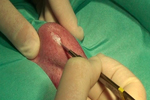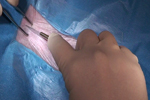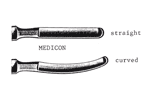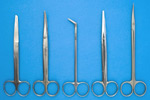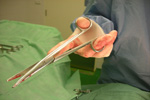Equipment Instruments
Unit 9: Basic Instruments
Topic 2a: Cutting Instruments
Scalpels
Initially most scalpels were of a simple knife-like construction which needed to be sharpened regularly as their use in tissues as well as heat and chemicals used for sterilisation quickly dulled the edges. Disposable blades which could then be attached to reusable handles were then developed in a number of sizes and shapes
Scalpel cuts should be made to minimize trauma to the surrounding tissues. This can be done by using a sharp (usually new) blade with sufficient pressure to complete the cut in one action. For a long cut it is important to use the whole of the cutting edge to complete the incision.
Avoid multiple timid (paint-brush) cuts as these will cause increased trauma, multiple bleeding sites and a ragged incision which may compromise subsequent healing. Always incise boldly!
Always incise at right angles to the skin to avoid excessive trauma to the associated skins and associated structures.
The scalpel may be gripped with a "pen" or "finger tip" grip. The latter being more useful for longer incisions.
Bistoury
This is a single piece robust knife which can be curved or straight with a rounded blunt tip. It is used most commonly in large animals for desmotomy and tenotomy.
Scissors
Next to the scalpel, scissors are the most commonly used instrument for cutting.
A large number of scissor types and shapes are available. It is important to recognise the indications and correct use for each type to avoid excess damage to the tissues or the instrument.
Types of scissors:
- Mayo scissors: Straight or curved, blunt-blunt scissors. Heavy duty scissors used for dissecting and cutting strong tissues such as fascia.
- Metzembaum scissors: Usually curved. Similar to mayo scissors but these scissors have shorter blades relative to the handles and a much more delicate action for dissection around delicate tissues.
- Iris scissors: Sharp-sharp scissors
- Blunt-Sharp scissors : These scissors are robust instruments designed for cutting materials such as excess suture material following suture placement. They are not a tissue scissor.
- Wire scissors: These are very strong scissor designed to cut surgical wire with a shearing action.
- Bandage scissors: These scissors usually have a protected end on the lower blade to protect the skin during bandage removal.
- Suture scissors: alternatively a #12 sterile disposable hook blade may be used.
All scissor actions have a crushing component to the cut and are more traumatic than a scalpel cut.
A "push-cut" can be used to open fascial planes such as fascia lama and the linea alba. Insert one blade under the tissue plane, partially close the scissor and advance the scissor at the same time.
Mayo scissors are better suited for dense tissues such as fascia, while Metzenbaum scissors are recommended for delicate tissues. To avoid blunting the blades, separate general purpose sharp/blunt scissors are used for cutting sutures.
Direction, control and accuracy in cutting depend on the stability of the tissue between the scissor blade and the stability of the scissors within the operator’s hand. The larger the angle between the blades, the less the tissue is stabilised. Cutting forces are also greatly attenuated if tissue engages the blades closer to the fulcrum.

Use the tips of scissor blades for cutting and keep the blades close together when cutting. For scissor cutting, the blades are nearly closed, advanced, and nearly closed again. For push cutting, the blades are initially nearly closed and continued by pushing the nearly closed scissor blades forward.
Scissors are best held with the tips of the thumb and ring finger through the rings of the scissor and with the index finger resting on the shanks near the fulcrum. Grasping scissors with the tips of the thumb and middle or index finger decreases stability and diminishes shear and torque forces for cutting.
If required a backhanded grip may be achieved with the thumb and index finger with the handle of the scissors in the palm of the hand.
Curved scissors offer greater mobility and visibility while straight scissors provide greater mechanical advantage. Most scissors are designed for a right-handed grip. A left-handed surgeon requires considerable practice to effectively use right-handed scissors. Most instrument companies manufacture left-handed instruments.

